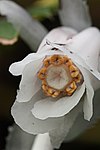Monotropa uniflora
| Monotropa uniflora | ||||||||||||
|---|---|---|---|---|---|---|---|---|---|---|---|---|

Monotropa uniflora |
||||||||||||
| Systematics | ||||||||||||
|
||||||||||||
| Scientific name | ||||||||||||
| Monotropa uniflora | ||||||||||||
| L. |
Monotropa uniflora is a species of plant from the genus Monotropa in the subfamily Monotropoideae within the heather family(Ericaceae). In the genus Monotropa there are only two types, the second type, the spruce asparagus ( Monotropa hypopitys L.) also occurs in Central Europe. Originally the genus Monotropa was placed in its own family of spruce asparagus plants (Monotropaceae).
description
Vegetative characteristics
Monotropa uniflora is a perennial, herbaceous plant that forms a rhizome for perpetuation . The plants do not contain any leaf green , but rather parasitize on their root fungi (myco heterotrophy ). This species differs from almost all other vascular plants by the white to pink color of the fleshy, waxy stems and inflorescences . Strong red specimens are rare. The aboveground plant parts are mostly bare. The plant parts turn black as they dry.
The leaves are reduced to 5 to 10 millimeters long scales.
Generative characteristics
At the end of the 10 to 30 centimeter long stem there is only one flower , which shows a certain similarity to the closely related species Monotropastrum humile and the distinction to the sister species Monotropa hypopitys . The flowers are usually 10 to 15 millimeters long and three to eight fold.
The upright capsule fruit is 1 to 1.5 centimeters long and ellipsoidal-spherical and contains several thousand seeds.
The seeds, which are about 0.1 millimeters long, are very small and elongated. The embryo is greatly reduced and consists of only four cells; the endosperm consists of only nine cells.
Chromosome set
The basic chromosome number is x = 8; it comes tetraploidy or Hexaploidie before, with a chromosome number of 2n = 32 or 48th
ecology
In contrast to most other plants, Monotropa species do not form chlorophyll . As an epiparasite , it gets its nutrients from mycorrhizal fungi on trees and bushes nearby. Monotropa species are not dependent on sunlight and can therefore grow in very dark locations in the undergrowth . Often near beeches .
Like most mycoheterotrophic plants, Monotropa uniflora only ever occurs in connection with a few specific hosts , all of which belong to the Russulaceae family .
English-language common names
English Ghost Plant, Ghost Pipe, Indian Pipe, Corpse Plant
distribution
The distribution area of Monotropa uniflora is disjoint . It occurs in Udmurtiya in the European part of Russia , in Asia (China, Tibet, Bangladesh, Bhutan, Nepal, Sikkim, India, Japan, Korea, maybe Myanmar) and is widespread from North to Central to northern South America .
Monotropa uniflora is generally rare.
Images of Monotropa uniflora
Each of the ten dust bags opens through two slits.
Large eyrie in Camano Island State Park .
swell
literature
- Qin Haining (覃海宁), Gary D. Wallace: Monotropa. : Monotropa uniflora , p. 256 - online with the same text as the printed work , In: Wu Zheng-yi, Peter H. Raven, Deyuan Hong (ed.): Flora of China. Volume 14: Apiaceae through Ericaceae. Science Press and Missouri Botanical Garden Press, Beijing and St. Louis. 2005, ISBN 1-930723-41-5 . (Sections Description and Distribution)
- Gary D. Wallace: Monotropa. : Monotropa uniflora , p. 392 - the same text online as the printed work , In: Flora of North America Editorial Committee (Ed.): Flora of North America North of Mexico. Volume 8: Magnoliophyta: Paeoniaceae to Ericaceae. Oxford University Press, New York and Oxford, 2009, ISBN 978-0-19-534026-6 . (Sections Description and Distribution)
Individual evidence
- ↑ a b c Qin Haining (覃海宁), Gary D. Wallace: Monotropa. : Monotropa uniflora , p. 256 - online with the same text as the printed work , In: Wu Zheng-yi, Peter H. Raven, Deyuan Hong (ed.): Flora of China. Volume 14: Apiaceae through Ericaceae. Science Press and Missouri Botanical Garden Press, Beijing and St. Louis. 2005, ISBN 1-930723-41-5 .
- ↑ David Matthews: "Indian Pipes, Ithaca NY" ( Memento of the original from September 5, 2012 in the Internet Archive ) Info: The archive link was inserted automatically and has not yet been checked. Please check the original and archive link according to the instructions and then remove this notice.
- ↑ JR Leake, SL McKendrick, M. Bidartondo, DJ Read: Symbiotic germination and development of the myco-heterotroph Monotropa hypopitys in nature and its requirement for locally distributed Tricholoma spp. In: New Phytologist, Volume 163, 2004, pp. 405-423. Full text online.
- ^ Gary D. Wallace: Monotropa. : Monotropa uniflora , p. 392 - the same text online as the printed work , In: Flora of North America Editorial Committee (Ed.): Flora of North America North of Mexico. Volume 8: Magnoliophyta: Paeoniaceae to Ericaceae. Oxford University Press, New York and Oxford, 2009, ISBN 978-0-19-534026-6 .
- ↑ Data sheet: Indian Pipe The Virtual Nature Trail at Penn State New Kensington. Pennsylvania State University 2002.
- ↑ S. Yang, DH Pfister: Monotropa uniflora plants of eastern Massachusetts form mycorrhizae with a diversity of russulacean fungi. In: Mycologia , 2006, Volume 98, Issue 4, pp. 535-540. doi : 10.3852 / mycologia.98.4.535 (pmid = 17139846)
- ↑ Ray Neyland, Melissa K. Hennigan: A Cladistic analysis of Monotropa uniflora (Ericaceae) inferred from large ribosomal subunit (26S) rRNA gene sequences. In: Castanea , Volume 69, Issue 4, 2004, pp. 265-271. doi : 10.2179 / 0008-7475 (2004) 069 <0265: ACAOMU> 2.0.CO; 2
Web links
- Indian Pipes, Ithaca NY Photo chronology of development in one season.
- USDA datasheet with distribution in North America.






